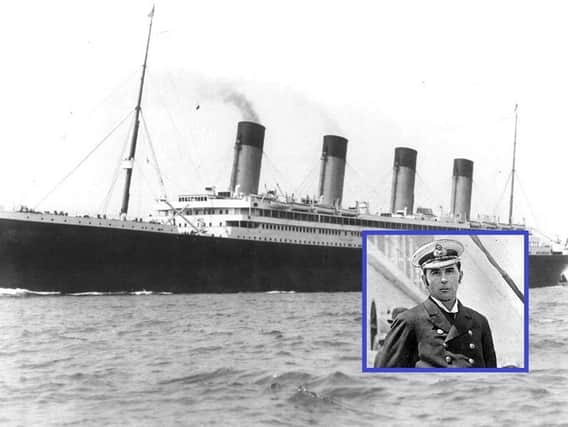Rugby's links with Titanic: The captain who made a daring rescue attempt and the Dunchurch woman who said Ismay was a good man


When the RMS Olympic received a transmission from her ailing sister ship Titanic on the night of April 14, 1912, 500 nautical miles separated them.
But its Rugby-born captain took the decision to set every available ounce of steam available into charging the Olympic at full speed an effort to save the 2,208 people aboard the Titanic.
Advertisement
Hide AdAdvertisement
Hide AdThe North Atlantic, wrote historian Christopher Ward, was so cold that night that it induced unbearable agony in anyone falling into it – even killing some instantly.
Olympic Captain Herbert Haddock was an experienced seaman - he would have likely known the terrible fate that would befall anyone who found themselves in the sea that night.
Captain Haddock was well-versed with the Titanic - he was her first captain, commanding the ship in Belfast before she was delivered to owner White Star Line and handed to Captain Edward Smith.
Despite the efforts of Captain Haddock, the Olympic was too far away to be able to assist, and when the ship had steamed to within around 100 nautical miles of the Titanic’s last recorded position, the captain of the RMS Carpathia, which had taken Titanic’s survivors on board, told Captain Haddock that there was nothing to be gained from heading further towards the site.
Advertisement
Hide AdAdvertisement
Hide AdThat request was made on behalf of Titanic owner Bruce Ismay, who felt the sight of the Titanic’s very similar sister ship might cause further distress to passengers. The Olympic then resumed her voyage towards Southampton, with Captain Haddock later assisting with inquiries.
Captain Haddock went on to serve in the First World War and later died in 1946.
The Olympic did not have enough lifeboats for all on board.
It was quickly fitted with additional lifeboats. When 284 of the ship’s firemen went on strike out of concerns for the sea-worthiness of the extra lifeboats, White Star Line hired additional crew. Some agreement was reached over the boats, but some crew refused to sail with the newly-hired non-union crew, with 54 sailors walking off.
They were arrested for mutiny but discharged from court. White Star Line, fearing public backlash, allowed the men back.
Advertisement
Hide AdAdvertisement
Hide AdWhen White Star Line managing director Bruce Ismay arrived in New York on April 18 with the other survivors of the sinking of the Titanic he was a broken man.
He only left his cabin aboard the RMS Carpathia, the ship which came to the rescue of Titanic’s passengers, when two senators arrived and served a summons for him to attend a formal inquiry into the sinking.
It was said that his hair went white overnight, and in the subsequent inquiries in which he gave testimony, witnesses said his voice was barely above a whisper.
Around 1,500 people, including Captain Smith went down with the Titanic - so why, people asked, did Mr Ismay survive?
Advertisement
Hide AdAdvertisement
Hide AdQuestions were raised over Mr Ismay’s involvement in the speed of the ship as it moved dangerously close to icebergs and the fact that he had decided not to provide enough lifeboats for all passengers so as not to clutter the decks did much to ruin his reputation.
But the allegation that would haunt him for the rest of his life was that of cowardice.
His decision to board a lifeboat, leaving two-thirds of the Titanic’s passengers to perish in the Atlantic, was one that set him aside from the stern, Edwardian values of the time.
But a Dunchurch woman who was, until her death in 2014, our town’s last living link towards Mr Ismay previously told the Advertiser that Mr Ismay was a decent man.
Advertisement
Hide AdAdvertisement
Hide AdAgnes Thwaite, maiden name Collins, was born on December 9, 1913.
She left school at 14 and with a wish to go into service, later working as cook and kitchen maid at the household of Mr Ismay.
“The Ismays were very kind, we were allowed to use their private beach and a little boat,” she said.
Mrs Thwaite married Mr Ismay’s top footman Angus Thwaite, and when the couple had their first baby Mr Ismay bought them a pram.
Advertisement
Hide AdAdvertisement
Hide AdShe said: “Because he took a spare place on the lifeboat, many said he should have gone down with Captain Smith.
“He was a very lonely man, spending many lonely hours in the park.”
Mrs Thwaite’s comments echoed the words of historians, who write that Mr Ismay largely withdrew from the outside world after the Titanic disaster, and would spend hours sitting in parks and talking homeless people.
“But the Ismays did have their own circle of people who remained loyal,” Mrs Thwaite added.
Advertisement
Hide AdAdvertisement
Hide AdMr Ismay was cleared of any wrongdoing in the inquiries following the sinking.
The number of lifeboats aboard the ship exceeded minimum regulations.
And it was suggested that he spent much time assisting women into lifeboats before taking a spare place on one of the last lifeboats to leave the ailing ship. A British inquiry found that the space on the lifeboat was spare, and Mr Ismay’s taking of it did not cause anyone to lose their life.